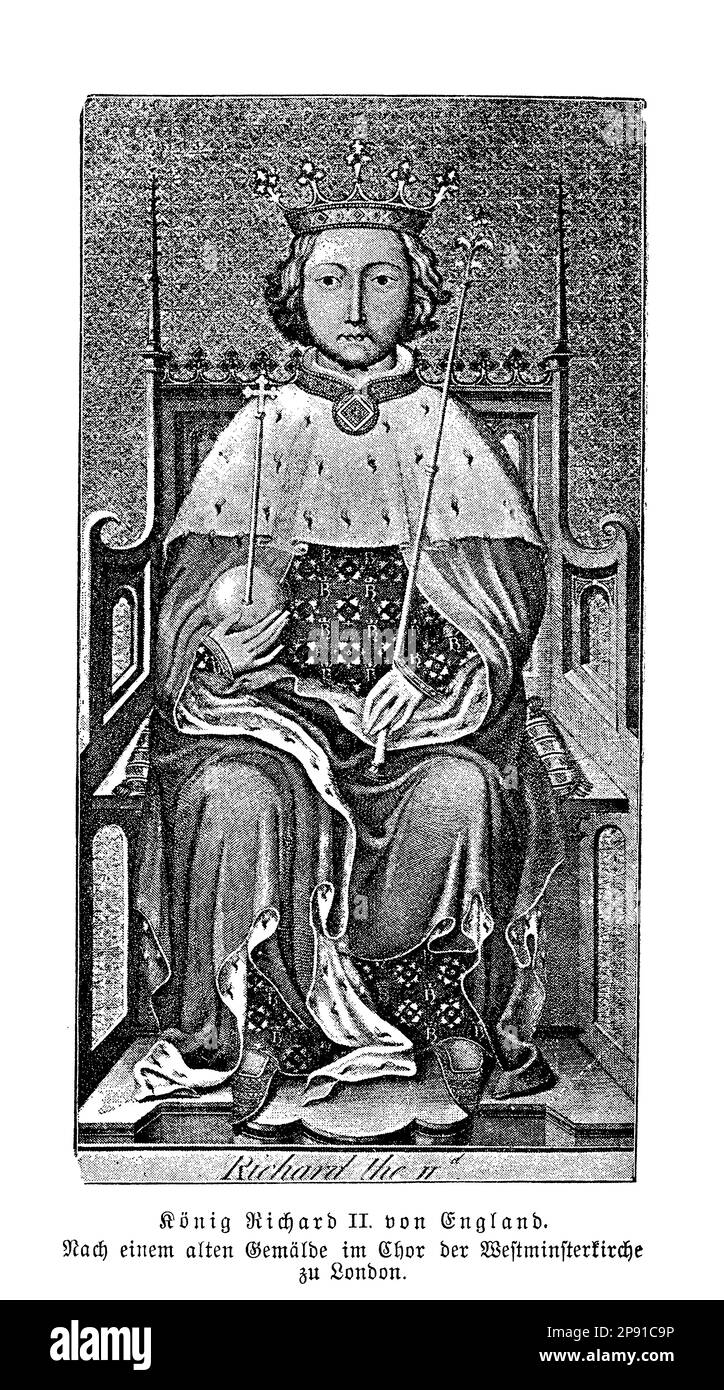Print marked middle Black & White Stock Photos
 Richard III (1452 – 1485) was King of England from 1483 until his death in 1485, at the age of 32, in the Battle of Bosworth Field. He was the last king of the House of York and the last of the Plantagenet dynasty. His defeat at Bosworth Field was the last decisive battle of the Wars of the Roses and marked the end of the Middle Ages in England. Stock Photohttps://www.alamy.com/image-license-details/?v=1https://www.alamy.com/stock-photo-richard-iii-1452-1485-was-king-of-england-from-1483-until-his-death-131106054.html
Richard III (1452 – 1485) was King of England from 1483 until his death in 1485, at the age of 32, in the Battle of Bosworth Field. He was the last king of the House of York and the last of the Plantagenet dynasty. His defeat at Bosworth Field was the last decisive battle of the Wars of the Roses and marked the end of the Middle Ages in England. Stock Photohttps://www.alamy.com/image-license-details/?v=1https://www.alamy.com/stock-photo-richard-iii-1452-1485-was-king-of-england-from-1483-until-his-death-131106054.htmlRMHH8B32–Richard III (1452 – 1485) was King of England from 1483 until his death in 1485, at the age of 32, in the Battle of Bosworth Field. He was the last king of the House of York and the last of the Plantagenet dynasty. His defeat at Bosworth Field was the last decisive battle of the Wars of the Roses and marked the end of the Middle Ages in England.
RM2XAP75K–The Eleanor Cross restored, in front of the Charing-Cross Hotel and Railway Station, [London], 1865. Fanciful reconstruction of the medieval cross. 'The very beautiful cross...is designed as a restoration of a most interesting historical memorial...the last...of the twelve crosses which marked the resting-places of the funeral procession which conveyed the body of Queen Eleanor, wife of Edward I...to her tomb in Westminster Abbey...The cross at Charing, like so many other precious monuments of the art of the Middle Ages, was swept away by iconoclastic Puritan bigotry in 1647...Mr. Edward M. Ba
![Middle East History - Palestine events. The 1929 riots August 23 to 31. Crosses on Christian homes. Marked so as not to be mistaken for Jews [Jerusalem?] Stock Photo Middle East History - Palestine events. The 1929 riots August 23 to 31. Crosses on Christian homes. Marked so as not to be mistaken for Jews [Jerusalem?] Stock Photo](https://c8.alamy.com/comp/2DE5YRX/middle-east-history-palestine-events-the-1929-riots-august-23-to-31-crosses-on-christian-homes-marked-so-as-not-to-be-mistaken-for-jews-jerusalem-2DE5YRX.jpg) Middle East History - Palestine events. The 1929 riots August 23 to 31. Crosses on Christian homes. Marked so as not to be mistaken for Jews [Jerusalem?] Stock Photohttps://www.alamy.com/image-license-details/?v=1https://www.alamy.com/middle-east-history-palestine-events-the-1929-riots-august-23-to-31-crosses-on-christian-homes-marked-so-as-not-to-be-mistaken-for-jews-jerusalem-image387364878.html
Middle East History - Palestine events. The 1929 riots August 23 to 31. Crosses on Christian homes. Marked so as not to be mistaken for Jews [Jerusalem?] Stock Photohttps://www.alamy.com/image-license-details/?v=1https://www.alamy.com/middle-east-history-palestine-events-the-1929-riots-august-23-to-31-crosses-on-christian-homes-marked-so-as-not-to-be-mistaken-for-jews-jerusalem-image387364878.htmlRM2DE5YRX–Middle East History - Palestine events. The 1929 riots August 23 to 31. Crosses on Christian homes. Marked so as not to be mistaken for Jews [Jerusalem?]
 Stephen (1092 – 1154), often referred to as Stephen of Blois, was a grandson of William the Conqueror. He was King of England from 1135 to his death, and also the Count of Boulogne in right of his wife. Stephen's reign was marked by the Anarchy, a civil war with his cousin and rival, the Empress Matilda. Stock Photohttps://www.alamy.com/image-license-details/?v=1https://www.alamy.com/stock-photo-stephen-1092-1154-often-referred-to-as-stephen-of-blois-was-a-grandson-128536650.html
Stephen (1092 – 1154), often referred to as Stephen of Blois, was a grandson of William the Conqueror. He was King of England from 1135 to his death, and also the Count of Boulogne in right of his wife. Stephen's reign was marked by the Anarchy, a civil war with his cousin and rival, the Empress Matilda. Stock Photohttps://www.alamy.com/image-license-details/?v=1https://www.alamy.com/stock-photo-stephen-1092-1154-often-referred-to-as-stephen-of-blois-was-a-grandson-128536650.htmlRMHD39PJ–Stephen (1092 – 1154), often referred to as Stephen of Blois, was a grandson of William the Conqueror. He was King of England from 1135 to his death, and also the Count of Boulogne in right of his wife. Stephen's reign was marked by the Anarchy, a civil war with his cousin and rival, the Empress Matilda.
 King Richard II of England was the last Plantagenet king and ruled from 1377 until his deposition in 1399. He was a controversial figure, known for his extravagance, religious piety, and authoritarian tendencies. His reign was marked by conflicts with the nobility, including his cousin Henry Bolingbroke, who would later depose him and become Henry IV Stock Photohttps://www.alamy.com/image-license-details/?v=1https://www.alamy.com/king-richard-ii-of-england-was-the-last-plantagenet-king-and-ruled-from-1377-until-his-deposition-in-1399-he-was-a-controversial-figure-known-for-his-extravagance-religious-piety-and-authoritarian-tendencies-his-reign-was-marked-by-conflicts-with-the-nobility-including-his-cousin-henry-bolingbroke-who-would-later-depose-him-and-become-henry-iv-image539084946.html
King Richard II of England was the last Plantagenet king and ruled from 1377 until his deposition in 1399. He was a controversial figure, known for his extravagance, religious piety, and authoritarian tendencies. His reign was marked by conflicts with the nobility, including his cousin Henry Bolingbroke, who would later depose him and become Henry IV Stock Photohttps://www.alamy.com/image-license-details/?v=1https://www.alamy.com/king-richard-ii-of-england-was-the-last-plantagenet-king-and-ruled-from-1377-until-his-deposition-in-1399-he-was-a-controversial-figure-known-for-his-extravagance-religious-piety-and-authoritarian-tendencies-his-reign-was-marked-by-conflicts-with-the-nobility-including-his-cousin-henry-bolingbroke-who-would-later-depose-him-and-become-henry-iv-image539084946.htmlRM2P91C9P–King Richard II of England was the last Plantagenet king and ruled from 1377 until his deposition in 1399. He was a controversial figure, known for his extravagance, religious piety, and authoritarian tendencies. His reign was marked by conflicts with the nobility, including his cousin Henry Bolingbroke, who would later depose him and become Henry IV
 Stag-hunting in the Reign of George II. - from a painting by Frederick Tayler, 1854. 'The stout, plump, coarse-bred horses; the huge hunting-horns; the yeoman pricker, with the slow lyme hounds in couples, with which he has marked down the stag for the swifter pack to "force" down - all speak of the age of slow, stately, scientific hunting, which was carried on in this country under the forms, and with the terms of our Norman conquerors, until the progress of agriculture thinned our forests and exterminated the great herds of deer, which, down to the middle of the eighteenth century, Stock Photohttps://www.alamy.com/image-license-details/?v=1https://www.alamy.com/stag-hunting-in-the-reign-of-george-ii-from-a-painting-by-frederick-tayler-1854-the-stout-plump-coarse-bred-horses-the-huge-hunting-horns-the-yeoman-pricker-with-the-slow-lyme-hounds-in-couples-with-which-he-has-marked-down-the-stag-for-the-swifter-pack-to-quotforcequot-down-all-speak-of-the-age-of-slow-stately-scientific-hunting-which-was-carried-on-in-this-country-under-the-forms-and-with-the-terms-of-our-norman-conquerors-until-the-progress-of-agriculture-thinned-our-forests-and-exterminated-the-great-herds-of-deer-which-down-to-the-middle-of-the-eighteenth-century-image481979131.html
Stag-hunting in the Reign of George II. - from a painting by Frederick Tayler, 1854. 'The stout, plump, coarse-bred horses; the huge hunting-horns; the yeoman pricker, with the slow lyme hounds in couples, with which he has marked down the stag for the swifter pack to "force" down - all speak of the age of slow, stately, scientific hunting, which was carried on in this country under the forms, and with the terms of our Norman conquerors, until the progress of agriculture thinned our forests and exterminated the great herds of deer, which, down to the middle of the eighteenth century, Stock Photohttps://www.alamy.com/image-license-details/?v=1https://www.alamy.com/stag-hunting-in-the-reign-of-george-ii-from-a-painting-by-frederick-tayler-1854-the-stout-plump-coarse-bred-horses-the-huge-hunting-horns-the-yeoman-pricker-with-the-slow-lyme-hounds-in-couples-with-which-he-has-marked-down-the-stag-for-the-swifter-pack-to-quotforcequot-down-all-speak-of-the-age-of-slow-stately-scientific-hunting-which-was-carried-on-in-this-country-under-the-forms-and-with-the-terms-of-our-norman-conquerors-until-the-progress-of-agriculture-thinned-our-forests-and-exterminated-the-great-herds-of-deer-which-down-to-the-middle-of-the-eighteenth-century-image481979131.htmlRM2K0418B–Stag-hunting in the Reign of George II. - from a painting by Frederick Tayler, 1854. 'The stout, plump, coarse-bred horses; the huge hunting-horns; the yeoman pricker, with the slow lyme hounds in couples, with which he has marked down the stag for the swifter pack to "force" down - all speak of the age of slow, stately, scientific hunting, which was carried on in this country under the forms, and with the terms of our Norman conquerors, until the progress of agriculture thinned our forests and exterminated the great herds of deer, which, down to the middle of the eighteenth century,
![The Loan Collection, South-Kensington, 1862. Ciborium, or pyx, in gilt metal, ornamented with plaques of niello-work and enamelled glass pastes. Italian work, thirteenth or fourteenth century...This very unusual and remarkable specimen has a very marked Byzantine aspect...The designs represented in...[the] plaques are half figures of the Apostles, Our Saviour (twice repeated), and other saints...These representations on the plaques of glass are executed in enamels and gold pencilling in a very remarkable and unusual manner, evidently vitrified, or "burnt in."...it seems suggestive of Stock Photo The Loan Collection, South-Kensington, 1862. Ciborium, or pyx, in gilt metal, ornamented with plaques of niello-work and enamelled glass pastes. Italian work, thirteenth or fourteenth century...This very unusual and remarkable specimen has a very marked Byzantine aspect...The designs represented in...[the] plaques are half figures of the Apostles, Our Saviour (twice repeated), and other saints...These representations on the plaques of glass are executed in enamels and gold pencilling in a very remarkable and unusual manner, evidently vitrified, or "burnt in."...it seems suggestive of Stock Photo](https://c8.alamy.com/comp/2WRGX4G/the-loan-collection-south-kensington-1862-ciborium-or-pyx-in-gilt-metal-ornamented-with-plaques-of-niello-work-and-enamelled-glass-pastes-italian-work-thirteenth-or-fourteenth-centurythis-very-unusual-and-remarkable-specimen-has-a-very-marked-byzantine-aspectthe-designs-represented-in-the-plaques-are-half-figures-of-the-apostles-our-saviour-twice-repeated-and-other-saintsthese-representations-on-the-plaques-of-glass-are-executed-in-enamels-and-gold-pencilling-in-a-very-remarkable-and-unusual-manner-evidently-vitrified-or-quotburnt-inquotit-seems-suggestive-of-2WRGX4G.jpg) The Loan Collection, South-Kensington, 1862. Ciborium, or pyx, in gilt metal, ornamented with plaques of niello-work and enamelled glass pastes. Italian work, thirteenth or fourteenth century...This very unusual and remarkable specimen has a very marked Byzantine aspect...The designs represented in...[the] plaques are half figures of the Apostles, Our Saviour (twice repeated), and other saints...These representations on the plaques of glass are executed in enamels and gold pencilling in a very remarkable and unusual manner, evidently vitrified, or "burnt in."...it seems suggestive of Stock Photohttps://www.alamy.com/image-license-details/?v=1https://www.alamy.com/the-loan-collection-south-kensington-1862-ciborium-or-pyx-in-gilt-metal-ornamented-with-plaques-of-niello-work-and-enamelled-glass-pastes-italian-work-thirteenth-or-fourteenth-centurythis-very-unusual-and-remarkable-specimen-has-a-very-marked-byzantine-aspectthe-designs-represented-in-the-plaques-are-half-figures-of-the-apostles-our-saviour-twice-repeated-and-other-saintsthese-representations-on-the-plaques-of-glass-are-executed-in-enamels-and-gold-pencilling-in-a-very-remarkable-and-unusual-manner-evidently-vitrified-or-quotburnt-inquotit-seems-suggestive-of-image599661344.html
The Loan Collection, South-Kensington, 1862. Ciborium, or pyx, in gilt metal, ornamented with plaques of niello-work and enamelled glass pastes. Italian work, thirteenth or fourteenth century...This very unusual and remarkable specimen has a very marked Byzantine aspect...The designs represented in...[the] plaques are half figures of the Apostles, Our Saviour (twice repeated), and other saints...These representations on the plaques of glass are executed in enamels and gold pencilling in a very remarkable and unusual manner, evidently vitrified, or "burnt in."...it seems suggestive of Stock Photohttps://www.alamy.com/image-license-details/?v=1https://www.alamy.com/the-loan-collection-south-kensington-1862-ciborium-or-pyx-in-gilt-metal-ornamented-with-plaques-of-niello-work-and-enamelled-glass-pastes-italian-work-thirteenth-or-fourteenth-centurythis-very-unusual-and-remarkable-specimen-has-a-very-marked-byzantine-aspectthe-designs-represented-in-the-plaques-are-half-figures-of-the-apostles-our-saviour-twice-repeated-and-other-saintsthese-representations-on-the-plaques-of-glass-are-executed-in-enamels-and-gold-pencilling-in-a-very-remarkable-and-unusual-manner-evidently-vitrified-or-quotburnt-inquotit-seems-suggestive-of-image599661344.htmlRM2WRGX4G–The Loan Collection, South-Kensington, 1862. Ciborium, or pyx, in gilt metal, ornamented with plaques of niello-work and enamelled glass pastes. Italian work, thirteenth or fourteenth century...This very unusual and remarkable specimen has a very marked Byzantine aspect...The designs represented in...[the] plaques are half figures of the Apostles, Our Saviour (twice repeated), and other saints...These representations on the plaques of glass are executed in enamels and gold pencilling in a very remarkable and unusual manner, evidently vitrified, or "burnt in."...it seems suggestive of
 The half hour before dinner, 1871. '...when half-past seven is marked by the gilt Paris clock on the mantelpiece, while the summons to walk into the dining-room is still delayed, it must be confessed that the power of dulness is heavily laid upon such a company as our Artist presents...The moment he has chosen...is one about to break the spell of commonplace stupidity and decorous apathy, by the coming announcement of a domestic disaster. This mishap may even relieve the spirits of those who can laugh at the loss of good victuals...The boy in buttons, or page...has just approached Mrs. Fidding Stock Photohttps://www.alamy.com/image-license-details/?v=1https://www.alamy.com/the-half-hour-before-dinner-1871-when-half-past-seven-is-marked-by-the-gilt-paris-clock-on-the-mantelpiece-while-the-summons-to-walk-into-the-dining-room-is-still-delayed-it-must-be-confessed-that-the-power-of-dulness-is-heavily-laid-upon-such-a-company-as-our-artist-presentsthe-moment-he-has-chosenis-one-about-to-break-the-spell-of-commonplace-stupidity-and-decorous-apathy-by-the-coming-announcement-of-a-domestic-disaster-this-mishap-may-even-relieve-the-spirits-of-those-who-can-laugh-at-the-loss-of-good-victualsthe-boy-in-buttons-or-pagehas-just-approached-mrs-fidding-image626636086.html
The half hour before dinner, 1871. '...when half-past seven is marked by the gilt Paris clock on the mantelpiece, while the summons to walk into the dining-room is still delayed, it must be confessed that the power of dulness is heavily laid upon such a company as our Artist presents...The moment he has chosen...is one about to break the spell of commonplace stupidity and decorous apathy, by the coming announcement of a domestic disaster. This mishap may even relieve the spirits of those who can laugh at the loss of good victuals...The boy in buttons, or page...has just approached Mrs. Fidding Stock Photohttps://www.alamy.com/image-license-details/?v=1https://www.alamy.com/the-half-hour-before-dinner-1871-when-half-past-seven-is-marked-by-the-gilt-paris-clock-on-the-mantelpiece-while-the-summons-to-walk-into-the-dining-room-is-still-delayed-it-must-be-confessed-that-the-power-of-dulness-is-heavily-laid-upon-such-a-company-as-our-artist-presentsthe-moment-he-has-chosenis-one-about-to-break-the-spell-of-commonplace-stupidity-and-decorous-apathy-by-the-coming-announcement-of-a-domestic-disaster-this-mishap-may-even-relieve-the-spirits-of-those-who-can-laugh-at-the-loss-of-good-victualsthe-boy-in-buttons-or-pagehas-just-approached-mrs-fidding-image626636086.htmlRM2YBDMM6–The half hour before dinner, 1871. '...when half-past seven is marked by the gilt Paris clock on the mantelpiece, while the summons to walk into the dining-room is still delayed, it must be confessed that the power of dulness is heavily laid upon such a company as our Artist presents...The moment he has chosen...is one about to break the spell of commonplace stupidity and decorous apathy, by the coming announcement of a domestic disaster. This mishap may even relieve the spirits of those who can laugh at the loss of good victuals...The boy in buttons, or page...has just approached Mrs. Fidding